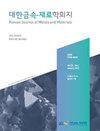复合材料在超疏水表面的动力学研究:液滴大小和形状的影响
IF 1.4
4区 材料科学
Q4 MATERIALS SCIENCE, MULTIDISCIPLINARY
引用次数: 0
摘要
复合材料具有两个或多个不可混合的部分,为了工程目的,这些部分彼此保持共享表面。这种复合材料,如Janus或核壳结构,为相关应用创造了机会,因为它们提供了复杂撞击材料和复杂表面的不同组合。然而,以前的研究只假设了球形配置,或专注于弹跳动力学,而没有考虑材料尺寸的影响。目前的工作数值研究了具有椭球形状的Janus材料在不同冲击速度和粘度比下的动力学特性,以分析材料的尺寸和形状对反弹和分离行为的影响。研究了碰撞后开始分离的阈值韦伯数作为液滴尺寸、椭圆率和粘度比的函数。此外,在不同的粘度比和韦伯数下,建立了Janus液滴分离效率的状态图,以研究液滴形状对不对称弹跳和分离行为的影响。研究发现,在相同的椭圆度下,两个长椭球体的分离效率和分离机理不同。这项研究将提供一种有效的策略来控制化合物材料在应用中的弹跳,如药物递送、液体纯化和生物或多材料打印。本文章由计算机程序翻译,如有差异,请以英文原文为准。
A Study on the Dynamics of Compound Materials on Superhydrophobic Surfaces: Effects of Droplet’s Size and Shape
Compound materials have two or more unmixable parts that retain a shared surface with one another for engineering purposes. Such compound materials, like the Janus or core–shell configurations, create opportunities for relevant applications because they offer diverse combinations of complex impinging materials and complex surfaces. However, previous studies have only assumed spherical configurations, or focused on the bouncing dynamics, without considering the effect of the material size. The current work numerically studies the dynamic characteristics of Janus materials with ellipsoidal shapes for various impact speeds and viscosity ratios, to analyze the effect of the size and shape of the material on bouncing and separation behavior. The threshold Weber numbers at which separation starts after the collision are investigated as a function of the droplet size, ellipticity, and viscosity ratio. In addition, a regime map of the separation efficiency of the Janus droplets is established under various viscosity ratios and Weber numbers to investigate the effects of droplet shape on the asymmetric bouncing and separation behavior. It is found that the separation efficiency and mechanism of two prolate spheroids are different from each other at the same ellipticity. This study will provide an efficient strategy to control the bouncing of compound materials in applications, such as drug delivery, liquid purification, and bio- or multi-material printing.
求助全文
通过发布文献求助,成功后即可免费获取论文全文。
去求助
来源期刊

Korean Journal of Metals and Materials
MATERIALS SCIENCE, MULTIDISCIPLINARY-METALLURGY & METALLURGICAL ENGINEERING
CiteScore
1.80
自引率
58.30%
发文量
100
审稿时长
4-8 weeks
期刊介绍:
The Korean Journal of Metals and Materials is a representative Korean-language journal of the Korean Institute of Metals and Materials (KIM); it publishes domestic and foreign academic papers related to metals and materials, in abroad range of fields from metals and materials to nano-materials, biomaterials, functional materials, energy materials, and new materials, and its official ISO designation is Korean J. Met. Mater.
 求助内容:
求助内容: 应助结果提醒方式:
应助结果提醒方式:


